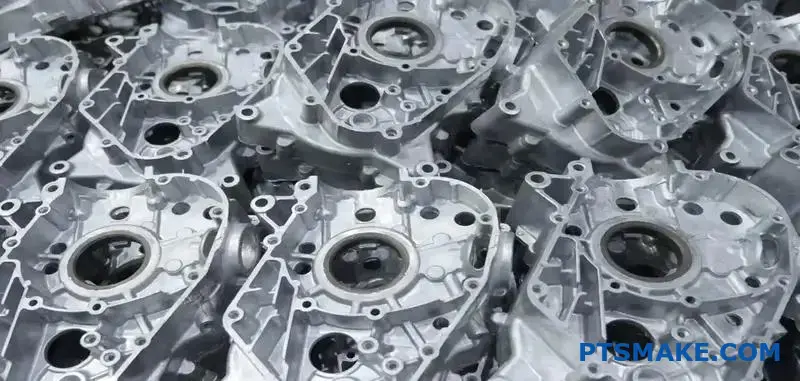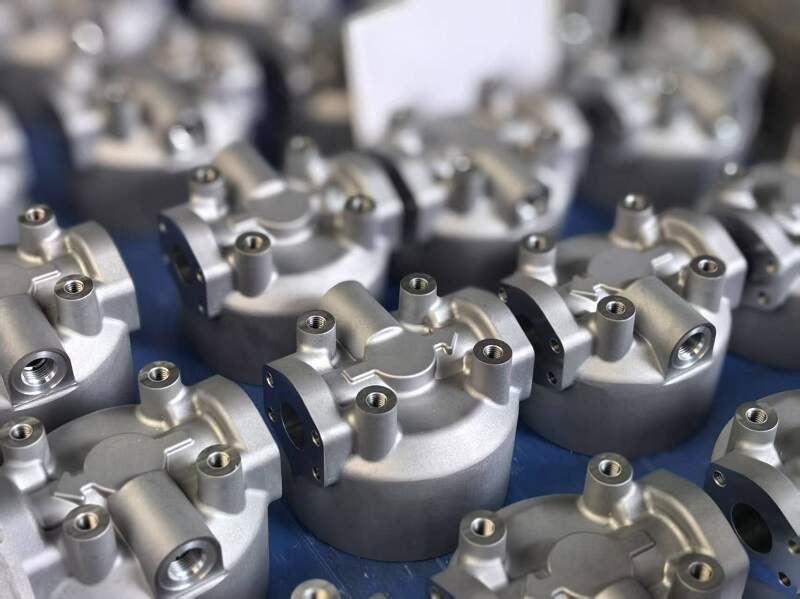Aluminum Casting Explained: Secret Truths and Insights for Industry Professionals
Aluminum casting works as a crucial procedure in modern-day production, forming elements throughout different markets. Its diverse techniques, such as sand and die casting, cater to various manufacturing requirements. The special buildings of aluminum alloys enhance their applicability, yet challenges continue to be in maintaining top quality and performance. Recognizing these aspects is important for market experts. What are the most up to date developments and finest practices that can even more maximize this process?
Summary of Aluminum Casting Processes

Crucial element of aluminum casting processes consist of the preparation of mold and mildews, which may be made from sand, steel, or ceramic products, depending upon the meant use. Furthermore, temperature level control is important to ensure appropriate melting and solidification of aluminum.
The casting procedure enables elaborate layouts and can accomplish high levels of dimensional precision. As soon as cooled, the spreadings may undergo completing procedures such as machining or surface therapy to satisfy details performance criteria. Generally, aluminum casting works as a functional manufacturing method, successfully meeting the varied demands of various industries.
Types of Aluminum Casting Approaches
In the domain name of aluminum casting, various methods are utilized to attain various outcomes. Sand casting strategies provide versatility and cost-effectiveness for complicated forms, while die casting processes supply high precision and effectiveness for automation. Comprehending these methods is crucial for selecting the appropriate technique based on task needs.
Sand Casting Techniques
Sand casting methods represent a fundamental method in aluminum casting, where sand is utilized as a mold material to form liquified metal. This procedure includes developing a pattern from the desired component, which is after that positioned in a sand mix to develop a mold. The sand is compacted around the pattern, and after removal, it produces a dental caries in the shape of the part. Molten aluminum is poured right into this cavity, permitting it to strengthen and cool down. One significant benefit of sand casting is its flexibility; it can suit huge parts and complex forms. In addition, the materials used are fairly low-cost, making it an available choice for various manufacturing applications in the aluminum sector.
Die Casting Processes
Die casting procedures are a popular approach for shaping aluminum components, utilizing high-pressure methods to force liquified steel right into precisely engineered mold and mildews. This procedure is specifically favored for its ability to produce complicated forms with tight tolerances and a smooth surface. There are two key types of die casting: hot chamber and cold chamber. Hot chamber die casting appropriates for metals with low melting factors, allowing for faster manufacturing prices. Alternatively, cool chamber die casting is excellent for higher melting factor steels, requiring a different melting heater. Both methods enhance efficiency and lower material waste, making them vital in automotive, aerospace, and customer goods sectors. Understanding these processes aids experts pick the most suitable method for their certain applications.
Product Properties of Aluminum Alloys

Strength and Longevity
Stamina and resilience are important attributes of aluminum alloys that make them ideal for various casting applications. These materials exhibit a positive strength-to-weight proportion, permitting for the creation of lightweight yet robust elements. With respect to tensile stamina, particular aluminum alloys can be crafted to stand up to substantial loads without flawing. This building is specifically vital in industries such as aerospace and automotive, where performance and safety and security are critical. Additionally, aluminum alloys typically retain their mechanical residential or commercial properties under varied temperature level problems, guaranteeing consistent efficiency. The intrinsic ductility of these alloys also enables for effective shaping during the casting procedure, making it simpler to produce complicated geometries. Overall, the toughness and sturdiness of aluminum alloys add substantially to their widespread use in innovative applications.
Deterioration Resistance Characteristics
While aluminum alloys are valued for their strength and lightweight properties, their deterioration resistance is another vital attribute that boosts their suitability for numerous applications. Aluminum normally develops a protective oxide layer when exposed to wetness, which helps to stop more oxidation. This inherent building makes aluminum alloys particularly useful in environments susceptible to deterioration, such as aquatic and industrial settings. In addition, various alloy make-ups can affect resistance levels, with particular alloys specifically crafted to improve this characteristic. Treatments like anodizing can additionally enhance deterioration resistance by thickening the oxide layer. Understanding the rust resistance of aluminum alloys is important for industry specialists when picking products for tasks needing resilience and durability in difficult settings.
Benefits of Aluminum Casting in Production
Aluminum casting deals various advantages in production, making it a recommended choice for various markets. One significant advantage is its light-weight nature, which adds to lowered transport prices and boosted energy performance in output. In addition, aluminum's superb thermal and electrical conductivity improves capability in applications needing warmth dissipation or electrical conduction.
The material's capacity to be cast right into complex shapes permits for style versatility, reducing the need for extra machining processes. In enhancement, aluminum casting exhibits exceptional rust resistance, bring about longer product lifespans and lower maintenance prices.

Typical Applications of Aluminum Castings
The adaptability of aluminum casting enables its extensive usage across numerous industries. Typical applications include automotive parts, where light-weight and corrosion-resistant elements, such as engine blocks and transmission real estates, boost lorry performance. In the aerospace market, aluminum spreadings are made use of for architectural elements, supplying stamina without including substantial weight.
In addition, the electrical industry gain from aluminum castings in manufacturing enclosures and warmth sinks, where thermal conductivity is essential. The durable goods field also integrates aluminum castings in products like kitchenware, furniture, and decorative products, integrating aesthetics with functionality.
The building industry employs aluminum spreadings for building aspects, home window frameworks, and fixtures, which offer sturdiness and layout adaptability. Overall, the varied applications of aluminum spreadings emphasize their relevance in modern manufacturing, adding to advancements in effectiveness and item design across several areas.
Technologies and Technical Innovations
As sectors remain to advance, innovations in aluminum casting modern technology are changing manufacturing processes and item capacities. Improvements in 3D printing and additive production have allowed the creation of complicated geometries that were formerly difficult to attain with traditional methods. These innovations enable for rapid prototyping, decreasing preparations and prices.
In addition, renovations in mold design and materials have boosted the casting process by enhancing performance and lowering waste. The combination of wise production strategies, such as IoT tools and real-time information analytics, enables far better surveillance and optimization of manufacturing specifications, causing better outcomes.
Additionally, developments in aluminum alloys provide boosted toughness, rust resistance, and lightweight homes, providing to the expanding demands in automobile review and aerospace industries. Collectively, these technologies are not just improving performance but additionally fulfilling the extensive requirements of modern engineering applications.
Finest Practices for Quality Assurance in Aluminum Casting
Making certain top notch results in aluminum casting needs adherence to best methods that incorporate different stages of the manufacturing process. Detailed product assessment is essential to confirm the top quality of aluminum alloys utilized, as impurities can considerably impact the last item. Applying accurate melting and pouring strategies lessens issues; keeping excellent temperatures avoids oxidation and advertises uniformity.
Mold style plays a crucial role; making use of computer-aided design (CAD) can improve accuracy and decrease human error. Routine monitoring of the cooling process is important to prevent bending and shrinking. Furthermore, using non-destructive testing approaches, such as ultrasonic or X-ray evaluations, assists recognize inner flaws without harming the components.
Finally, establishing a feedback loophole with drivers and engineers promotes constant improvement, making sure that high quality control measures Find Out More progress along with technical innovations. By following these ideal techniques, makers can enhance the reliability and performance of aluminum castings.
Regularly Asked Inquiries
What Are the Ecological Impacts of Aluminum Casting?
The ecological impacts of aluminum casting consist of considerable energy intake, greenhouse gas exhausts, and potential water pollution from shop operations. Furthermore, bauxite mining for aluminum ore can lead to environment destruction and dirt degradation.
Just How Does Aluminum Casting Compare to Other Steel Casting Processes?
Aluminum casting normally uses benefits in lightweight components and corrosion resistance compared to other procedures, such as iron or steel casting, which might offer higher toughness but cause larger and much less corrosion-resistant products. - Aluminum Foundry
What Prevail Issues in Aluminum Castings and Their Reasons?
Usual flaws in aluminum spreadings include porosity, shrinkage, and incorporations. Reasons frequently come from inappropriate putting techniques, insufficient mold style, or contamination of the molten metal, influencing the final product's honesty and performance.
What Safety and security Precautions Should Be Taken During Aluminum Casting?
Throughout aluminum casting, important safety preventative measures consist of wearing safety equipment, making certain appropriate air flow, preserving a tidy work space, taking care of molten steel with care, and complying with well established protocols to lessen dangers of burns, inhalation risks, and accidents.
How Can I Boost the Performance of My Aluminum Casting Procedures?
To enhance effectiveness in aluminum casting operations, one should maximize mold and mildew design, simplify material handling, employ automated procedures, carry out routine maintenance on tools, and purchase worker training to boost abilities and efficiency.
Numerous techniques exist, aluminum casting encompasses a number of main processes that cater to various applications and demands. Trick elements of aluminum casting processes consist of the preparation of molds, which may be made from sand, metal, or ceramic products, depending on the intended use. Sand casting techniques stand for a fundamental method in aluminum casting, where sand is used as a mold and mildew material to shape molten steel. As markets proceed to develop, innovations in aluminum casting technology are changing production procedures and product capabilities. Making certain top notch outputs in aluminum casting needs adherence to ideal practices that encompass different phases of the manufacturing procedure.